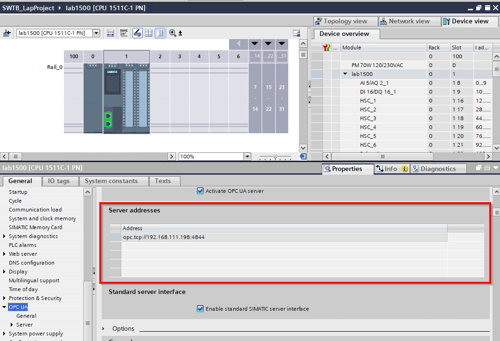With the relatively recent availability of OPC UA server capabilities in Siemens S7-1500 PLCs, access to live production data is now open to third-party applications. As a result, those applications can now communicate with hardware that was formerly locked behind proprietary communication drivers.
The OPC Data Logger's OPC UA client interface allows users to quickly and easily connect to S7-1500 PLC’s and log data to their preferred data storage option without the need for intermediate applications. This blog post covers the high-level steps involved with logging data from an S7-1500 controller and you can then download the free hands-on guide with detailed steps.
The current S7-1500 series of PLCs has an embedded OPC UA server right in the controller which opens the door for faster and more efficient communications that are more reliable and secure. Also, since it's standards-based, there is greater compatibility for connecting third-party systems that support OPC UA directly to S7-1500 controllers.
The OPC UA interface in the S7-1500 also offers a few other advantages over the traditional Siemens TCP (RFC1006 ISO over TCP) protocol:
- Greater Efficiency
- Greater Security
Since OPC UA allows Report-By-Exception (RBE), the ability to transfer arrays and a larger maximum packet size, OPC UA is Siemens preferred method of integrating S7-1500 controllers due to those improvements in efficiency.
Since the OPC Data Logger natively support OPC UA, it's easy to connect directly to the embedded OPC UA Server in an S7-1500 and get started logging your process data.
Step 1: Create the OPC Data Logger UA Connection
To start, the connection to the S7-1500's OPC UA server – where the data will be originating – must be configured in the OPC Data Logger. This involves defining a standard OPC UA data collector in your OPC Data Logger project.

For this, you'll also need access to the S7-1500 using the TIA Portal configuration and programming software so you can determine the available OPC UA server endpoints (located in the OPC UA Server configuration section of TIA Portal.

For details on configuring the OPC UA connection, get your free copy of the hands-on guide.
Step 2: Create OPC Data Logger Logging Task and Group
With the Data Collector created, the Logging task and the logging Group(s) must now also be added. The Logging task will drive the logging of all the other components, and is the object that links the collector, presentation, storage, and items.

The group is a collection of items that will be logged; a logging task can contain one or many logging groups.

For full details on configuring the logging task and logging groups, get your free copy of the hands-on guide.
Step 3: Create the OPC Data Logger Data Presentation
With the data points that need to be logged selected, the data presentation, which is how the data will be actually be formatted when logged to your chosen database or file, must be configured.

For full details on configuring the data presentation, get your free copy of the hands-on guide.
Step 4: Create the OPC Data Logger Data Storage
With all other components created, the Data Storage component needs to be added. OPC Data Logger supports the ability to log to databases such as ODBC-compliant databases, SQL and Oracle, as well as simple CSV logging.

For full details on configuring the data storage settings, get your free copy of the hands-on guide.
Step 5: Testing Data Logger UA Connection to S7-1500
With every component configured, enabled and connected, the OPC Data Logger project can be saved and tested. OPC Data Logger includes a convenient "Test Run" feature that steps through your configuration, makes all of the necessary connections and tests your settings to ensure your data is logged as desired. For full details on testing and running your OPC Data Logger project, get your free copy of the hands-on guide.

This post is intended to briefly show the general steps you can expect when configuring a connection to your S7-1500 from the OPC Data Logger. When you're ready to get started, get your copy of our detailed how-to guide for setting up and connecting to the embedded UA server in your S7-1500s with the OPC Data Logger.
And, if you haven't already downloaded the latest free trial of OPC Data Logger, click here.




